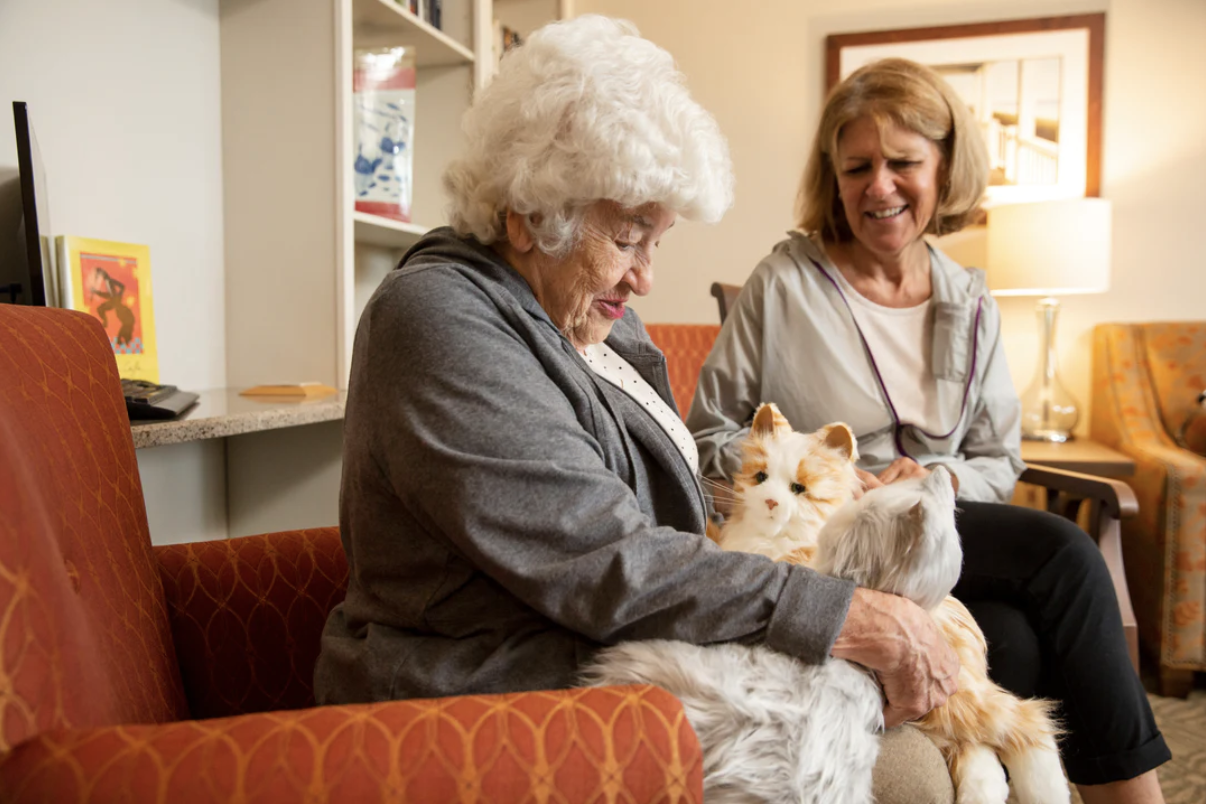With Robotic Pets, the Future Is Now
Photo courtesy of Joy for All Companions
We’ve written before about the many benefits that technology can bring to the lives of people who are trying to live independently and “age in place”. But we recently ran across a chapter of the “seniors and technology” story that seemed like something from a sci-fi movie—think “Marley and Me” mixed with “Lightyear,” and you’re getting close.
They’re robotic pets, and they’re stepping off the big screen and into the homes and lives of elderly people, with studies worldwide showing real benefits to their use. They’ll never replace human interaction, of course, but robot pets can lessen the burden of loneliness, which can damage and even shorten the lives of many seniors, and even lead to improved interaction between seniors and the other people in their lives.
For example, University of Utah researcher Rhonda Nelson and graduate student Rebecca Westenskow studied interactions with robotic pets by older adults with dementia. The research team used robotic cats and dogs from the Joy for All Companion line. These fluffy, furry creatures look like slightly realistic stuffed animals and are definitely made for cuddling. The pets have sensors that allow them to respond to touch, make sounds when lights are turned on or when they are stroked, and turn their heads. Users can feel heartbeats in the puppies and vibrating purrs in the cats.They’re also affordable, at between $100 and $150 each.
Photo courtesy of Joy for All Companions
In their study, Nelson and Westenskow “introduced” seniors with dementia to a robotic pet by asking something like, “Would you like to hold my dog?” They would then observe the seniors’ interactions with the pet and ask them questions about their experience.
Though the study was cut short by the COVID-19 pandemic, data collected by Nelson and Westenskow showed that every study participant reported enjoying the robotic pets. Most participants spoke with, held, and petted the animals. Nelson said the seniors didn’t appear to know the pets were not alive, though the researchers were ready to confirm that to anyone who asked. She added that regular sessions with those or other robotic pets could provide important benefits for elderly people with dementia.
“People in long-term care facilities are in a position where everybody provides care to them, and to be in the role where you are nurturing something else, or you are the caregiver I think is also psychologically very comforting for people to feel like, even though they know that it’s not live, they’re the person who’s giving love and compassion to something, and it’s responding,” Nelson said in a 2022 press release on the project.
Other research has focused on the potential helpfulness of robotic pets to seniors who are hoping to age in place, but who struggle with loneliness. These folks are well aware that the “pet” they’re playing with isn’t a real animal. But many enjoy it, anyway. In fact, research examining use of robotic pets among “community-dwelling” seniors—published in 2020 by the National Library of Medicine, a division of the National Institutes of Health—concluded that “social robots” can confer many of the benefits of owning a living pet.
“Robotic pets may be an effective solution for alleviating loneliness in older adults, especially among those who live alone, have fewer social connections, and live less active lifestyles,” the NLM article concluded. In other words, the most lonely and isolated study participants were most likely to enjoy “high engagement” with their robotic pets, including frequent physical touch, talking with the pet or using the pet as a way to talk with others, and including the pet in daily activities. Some study participants said they wished the pet could walk, play games with them, and/or follow them around the house, more like a “real” pet.
These wishes reflect the very real need of American seniors. The NLM article noted that “social isolation contributes to an additional $6.7 billion in Medicare spending annually,” as well as an additional $81 per Medicaid beneficiary per month in spending on additional time in skilled nursing facilities or other impatient settings. “This increase in spending … suggested that socially isolated individuals may be sicker when hospitalized, and may lack the support to transition out of the hospital successfully as compared to socially connected individuals,” the study reads. In other words, many seniors are lonely at levels that threaten their health and wellbeing, and a robotic pet that helps ease that loneliness can make a measurable positive difference in their lives.
Photo courtesy of aibo/Sony
Robotic pets aren’t only the purview of academics and tinkerers, either. The Joy for All pets are being further developed jointly by toy-making behemoth Hasbro and the Brown University Humanity Centered Robots Initiative, with plans to advance the devices’ “sensory, cognitive, and communicative capacities” so that they can interact more naturally and even help support people in their “life tasks.” Another huge company, Sony, sells aibo, a “robotic puppy, powered by AI” that makes eye contact, shows facial expression and emotion, wags its tail, “eats” and “drinks” from accessory bowls, and can learn tricks and recognize multiple people’s voices. It even puts itself “to bed” on a charger when its internal batteries run low. All of this interactivity and potential for growth comes at a price—aibo retails for about $2,900—but might be worth it for people who want the sociality of pet ownership without many of its expenses and challenges.
Another robotic pet, PARO, is a fluffy seal that’s been around since the early 2000s and is in its eighth generation. This longevity has allowed fairly extensive study of the potential benefits of the PARO robot on residents of care centers, many of them people with dementia. According to its website, PARO has been found to reduce patient and caregiver stress, stimulate interaction between patients and caregivers, and improve patient relaxation, motivation, and socialization. PARO devices are warm and lifelike to the touch, possess some of the same learning and interactive capabilities as aibo, and can move their eyes, heads, flippers, and tails, though they can’t walk. “PARO visits” have become a part of the therapeutic practices of care centers across the world, justifying the device’s steep $6,000 cost.
To be sure, there are ethical and other implications to the increasing use of robotic and artificial intelligence devices to help meet the needs of elderly people. But considering the crisis of loneliness that is gripping seniors across the world, it makes sense that many caregivers are opting to figure out those issues as they go, and get a robot pet into the hands and homes of people who might benefit from having one.



